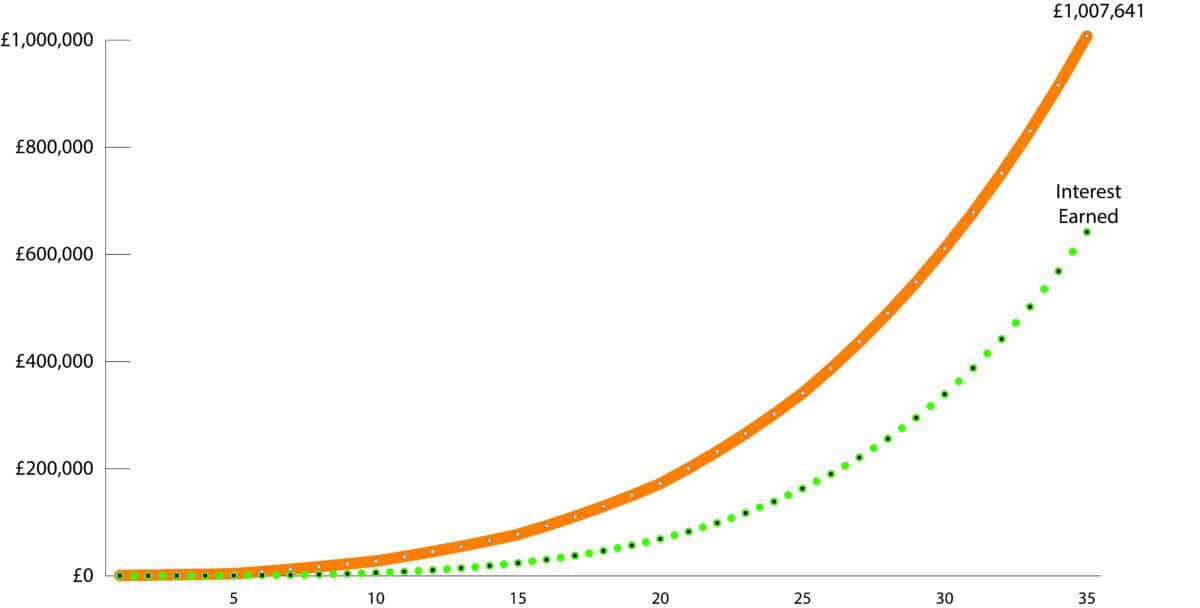How to target a £1m SIPP by growing contributions over time


A SIPP is one of the most efficient ways to build a sizeable nest egg, capable of supporting a comfortable retirement. For a basic rate tax-payer, for every £1 contribution made, the government will top it up by 25p. That’s extremely generous in my book, particularly if one intends to make regular contributions over decades.
Please note that tax treatment depends on the individual circumstances of each client and may be subject to change in future. The content in this article is provided for information purposes only. It is not intended to be, neither does it constitute, any form of tax advice. Readers are responsible for carrying out their own due diligence and for obtaining professional advice before making any investment decisions.
Increasing contributions
If an individual contributed £10 a week to their SIPP, with basic rate tax relief that would equate to £650 a year. Assuming a rate of return of 8%, it would take 62 years to reach £1m!
Of course, the reality is that oneâs earning potential increases with time. If we assume an employment career lasts 35 years, let us plot out a realistic tiered contribution increase that gets someone to that magical £1m.
| Tiered years | Basic yearly contribution | Contribution with basic tax relief |
| 1-5 | £520 | £650 |
| 6-10 | £3,000 | £3,750 |
| 11-15 | £5,000 | £6,250 |
| 16-20 | £8,000 | £10,000 |
| 21-25 | £12,000 | £15,000 |
| 26-35 | £15,000 | £18,750 |
As the graph highlights below, based on the above payment structure, two-thirds of the total £1m pot will have come from compounding interest along the way.

Chart generated by author
Passive vs active investing
Over such an extended period of time, compounding returns at 8% a year will be tough. Do not assume that because the S&P 500 and the FTSE 100 have recently beat this target, that this will continue for the next 35 years.
Along the way, there will be bear markets and years where returns are meagre. If you invest solely in an index, then your returns are tied to the fate of that index. For example, with the top 10 stocks accounting for 40% of the weighting in the S&P 500, if they falter then your portfolio will decline, regardless of how the other 490 perform.
However, if an investor mixes a passive strategy with active stock picking, then they are no longer solely beholden to the whims of an index.
Life insurer
If I ignore WPP, whose share price has collapsed pushing up its yield, and Taylor Wimpey (soon to be demoted to the FTSE 250), the top three dividend payers in the FTSE 100 today come from financial services. These include Legal & General (at 9.2%), Phoenix Group (LSE: PHNX) (at 8.5%) and M&G (at 8%).
At the moment, I particularly like Phoenix Group. An âaccounting mismatchâ spooked the market during its H1 results earlier this month. It has since clawed back most of the one-day losses, as investors realised that such a technicality had no impact on the main constituent of dividend sustainability or operating cash generation.
Over the past 10 years, the business has increased its dividend per share by 32%. As the workplace retirement savings market continues to grow over the next decade, its leading brand, Standard Life, is well placed to capitalise on such a trend.
Like many of its competitors, investorsâ preference for low-cost passive index-trackers has resulted in fund outflows, lowering fee revenues. Should this issue continue, then this could put pressure on margins and cash flow, threatening future dividend increases.
But with so few people taking financial advice leading up to retirement, and with increasing public awareness of the need to save more during working age, I expect the business to continue to generate healthy profits well into the future.
The post How to target a £1m SIPP by growing contributions over time appeared first on The Motley Fool UK.
Should you invest £1,000 in Phoenix Group Holdings plc right now?
When investing expert Mark Rogers has a stock tip, it can pay to listen. After all, the flagship Motley Fool Share Advisor newsletter he has run for nearly a decade has provided thousands of paying members with top stock recommendations from the UK and US markets.
And right now, Mark thinks there are 6 standout stocks that investors should consider buying. Want to see if Phoenix Group Holdings plc made the list?
More reading
- Here’s how ISA investors could target a comfortable retirement with dividend shares
- 8.6% dividend yield! See how much a £10,000 investment in Phoenix shares could potentially grow to
- Why am I increasing my investment in 8.7%-yielding Phoenix after its share price fell 6.5% on H1 results?
- Why has the Phoenix Group share price fallen 7% today?
- Are 8.5%-yielding Phoenix shares an unmissable bargain after todayâs surprise 5% drop?
Andrew Mackie has no position in any of the shares mentioned. The Motley Fool UK has no position in any of the shares mentioned. Views expressed on the companies mentioned in this article are those of the writer and therefore may differ from the official recommendations we make in our subscription services such as Share Advisor, Hidden Winners and Pro. Here at The Motley Fool we believe that considering a diverse range of insights makes us better investors.





